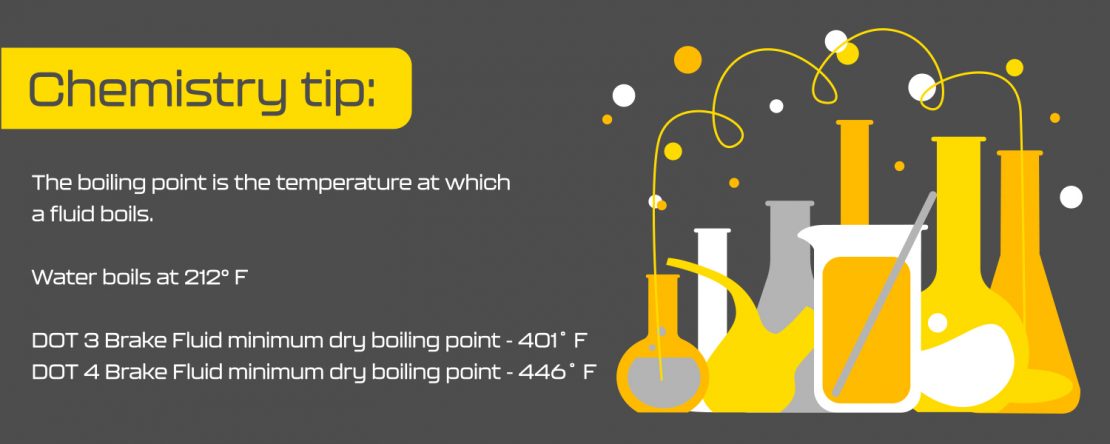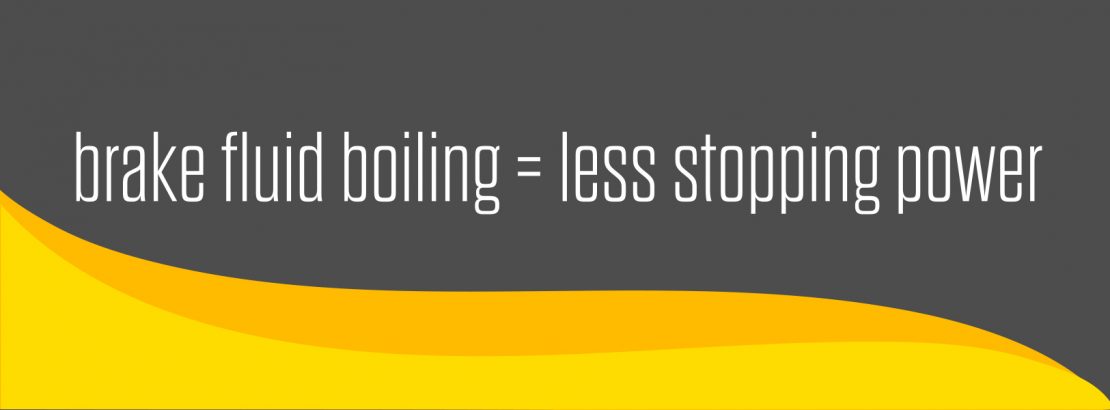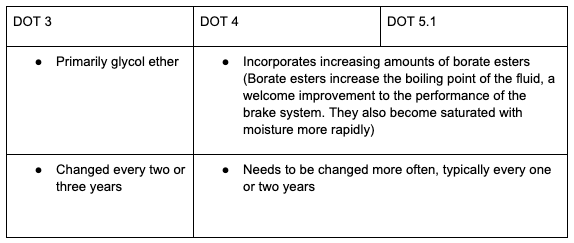Everything You Need to Know About Brake Fluid
November 19, 2020
I field a lot of questions from service technicians about brake fluid selection and compatibility.
It’s understandable considering the variety of brake fluid types available on the market today.
Brake fluids are broken down into several categories and this leads to uncertainty and confusion. So, which one is the right one?
Brake fluid standards
First, let’s get some clarity on what the different brake fluid categories actually mean. As I mentioned, there are several types out there. They are governed, primarily, by three internationally recognized standards organizations.
Federal Motor Vehicle Safety Standards (FMVSS)
The FMVSS breaks down brake fluid into a few different types. These include DOT 3, DOT 4, and DOT 5. DOT 5 is further segregated into two categories: DOT 5 (silicone-based brake fluid) and DOT 5.1 (non-silicone-based brake fluid). Also, DOT=Department of Transportation.
International Standards Organization (ISO)
In addition to DOT ratings, ISO classifies brake fluids under the ISO 4925 document: Class 3, Class 4, Class 5.1, and Class 6. ISO 4925 Class 6 fluid is commonly referred to as low viscosity brake fluid.
Society of Automotive Engineers (SAE)
Not to be left out, the SAE classifies brake fluids into three grades: SAE J1703, SAE J1704, and SAE J1705.
That’s enough to make a person dizzy!
DOT brake fluid specs
The most common brake fluid classifications are those set by the DOT. These fluids are recognized by the FMVSS under FMVSS No. 116 which specifies certain performance requirements for each type of fluid.
These brake fluid requirements also mimic the specifications of the corresponding ISO and SAE fluids. They are set forth to regulate fluid performance criteria, most importantly boiling point and viscosity.
What is a brake fluid boiling point?
First, let’s look at the boiling point.

Why is a brake fluid boiling point important?
Brake fluids have to meet FMVSS No. 116 specifications for minimum dry and wet boiling points. The dry boiling point is measured on new fluid from a sealed container presumed to contain zero percent water.
The wet boiling point is measured on fluid that contains 3.7 percent water. This is meant to represent used, worn-out brake fluid. Each brake fluid type has its own standard for minimum boiling point.
It’s common for moisture to show up in the brake system over time. But too much moisture:
- Degrades performance by lowering the boiling point of brake fluid
- Promotes brake system corrosion that can lead to catastrophic brake failure
This is because water has a lower boiling point than brake fluid, so the higher the water content, the lower the boiling point.
Why is a lower brake fluid boiling point bad?
When brakes are used aggressively or under heavy braking maneuvers, there is tremendous heat generated in the system. This heat can cause the brake fluid in the brake calipers to boil, which creates vapor.
Since brakes operate hydraulically, it’s important that the fluid is not compressible. Vapor is a gas. So having vapor in the fluid dramatically increases compressibility and reduces stopping power.

What does viscosity have to do with brake fluid?
The viscosity (thickness) of brake fluid has become increasingly important in modern vehicles. This is due to the advancement of computerized safety systems like Electronic Stability Programs (ESP) which utilize Anti-Lock Braking Systems (ABS) and Traction Control Systems (TCS).

Back in the old days, you had to manually pump the brake pedal while driving in slippery conditions. This was to prevent the brakes from locking up, causing the vehicle to spin out of control. In newer vehicles with ABS, the computer does this for us. It generates rapid pulsations of the brakes when it detects one of the wheels locking up or not rotating proportionally to the speed of the vehicle.
HOWEVER, in order for these systems to work properly, they have to be able to actuate the brake calipers up to 15 times per second. That means brake fluid has to have a very low viscosity (it has to be thin) and flow readily, especially in cold temperatures. Thick, high viscosity brake fluid could never achieve this kind of responsiveness.
What’s the difference between DOT 3, DOT 4, and DOT 5.1?
DOT 3, DOT 4, and DOT 5.1 brake fluids are all chemically similar. They all share these characteristics:
- They contain glycol ether and borate esters.
- When new, they are colorless or pale yellow and clear.
- They have a strong affinity for water (hygroscopic), meaning they attract it and water blends with the fluid.
And here are the basics of how they are different:

PRO TIP: Brake fluid that is dark or stained has accumulated moisture, or other contaminants, and needs to be changed.
DOT 5 brake fluid is quite different
DOT 5 brake fluid is far less common. It’s a silicone-based fluid that is hydrophobic. It repels water, which is perhaps good in theory but not in application.
When moisture gets in a brake system with this type of fluid, water will form a separate layer instead of blending into the fluid.
This causes MAJOR problems with corrosion because the water tends to pool in the system.
A word of caution: If a glycol-based fluid is mixed with a silicone-based fluid, the mixture will gel and cause catastrophic damage to a brake system.
For example: DOT 5 brake fluid should never be mixed with the DOT 3, DOT 4, or Dot 5.1 brake fluid types. DOT 5 brake fluid is typically purple in color so it can be easily recognized.
Which brake fluid is right for which car?
- Check the owner’s manual
- Check the master cylinder reservoir cap
The higher the DOT number, the higher the quality of brake fluid. You must use the OEM recommended brake fluid type or better. Meaning:
If your car calls for DOT 4 brake fluid, do not substitute DOT 3 as a replacement. However, if your car lists DOT 3 brake fluid, it is acceptable to use DOT 4 or DOT 5.1. (Not DOT 5!) You will simply be substituting a higher quality fluid for the lower quality DOT 3.
Side Note: There are other brake fluids on the market that are referred to as “Super DOT 4” or “DOT 4 Plus.” However, there are no formal standards for these fluids beyond the FMVSS No. 116 DOT 4 performance criteria. They do generally align with the higher quality DOT 5.1 fluid standards.
The good news? Whatever vehicle you drive, BG Products has a high-quality brake fluid for you!
We offer DOT 3, DOT 4, Super DOT 4, and low viscosity DOT 4 brake fluids. They all meet FMVSS No. 116, ISO4925, and SAE testing specifications for automotive brake fluids.
Key takeaway:
The most important system in a vehicle is the brake system. Exposure to extreme heat and the inevitable migration of moisture into this system can take a quick toll on brake fluid.
 By Andy Berlin
By Andy Berlin
BG Product Technical Service Representative
Andy has more than 20 years of experience as a chemist and laboratory analyst prior to joining the BG Products R&D team. He acts as a technical advisor, helping international and domestic Distributors and Sales Representatives understand BG product chemistry and applications.
